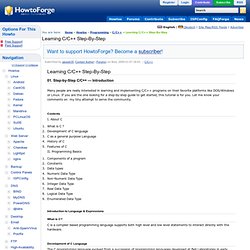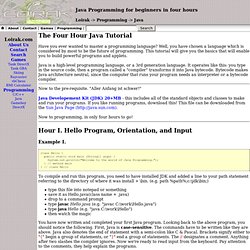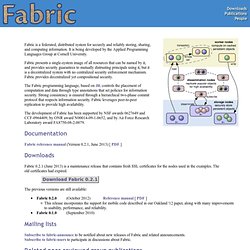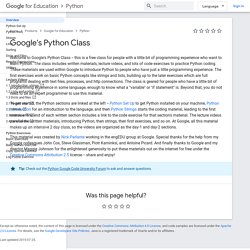

Sentinel value. Below are some examples of common sentinel values and their uses: Null character for indicating the end of a null-terminated stringNull pointer for indicating the end of a linked listA negative integer for indicating the end of a sequence of non-negative integersEnd-of-file, a non-character value returned by certain input routines to signal that no further characters are available from a fileHigh Values, a key value of hexadecimal 0xFF used in business programming A related practice, used in slightly different circumstances, is to place some specific value at the end of the data, in order to avoid the need for an explicit test for termination in some processing loop, because the value will trigger termination by the tests already present for other reasons.

Sentinel values are often used when searching for something[clarification needed][why?] Of importance.[3] See also[edit] Notes[edit] Jump up ^ Knuth, Donald (1973). Learning C/C++ Step-By-Step. 01.

Step-by-Step C/C++ --- Introduction Many people are really interested in learning and implementing C/C++ programs on their favorite platforms like DOS/Windows or Linux. If you are the one looking for a step-by-step guide to get started, this tutorial is for you. Let me know your comments on my tiny attempt to serve the community. Contents I. What is C ? II. Components of a program Constants Data types Numeric Data Type Non-Numeric Data Type Integer Data Type Real Data Type Logical Data Type Enumerated Data Type Introduction to Language & Expressions What is C? C is a compiler based programming language supports both high level and low level statements to interact directly with the hardware.
Development of C Language The C programming language evolved from a succession of programming languages developed at Bell Laboratories in early 1970s. UNIX operating system is written in the C language. App Inventor (Beta) Project Euler. Allegro - A game programming library - Page not found. Application Resources. Java Programming for beginners in four hours. The Four Hour Java Tutorial Have you ever wanted to master a programming language?

Well, you have chosen a language which is considered by most to be the future of programming. This tutorial will give you the basics that will enable you to build powerful programs and applets. Java is a high-level programming language, or a 3rd generation language. It operates like this: you type in the source code, then a program called a "compiler" transforms it into Java bytecode. Now to the pre-requisite. Java Developement Kit (JDK) 20+MB - this includes all of the standard objects and classes to make and run your programs. Now to programming, in only four hours to go! Hour I. Example I. class Hello { public static void main (String[] args) { System.out.println("Welcome to the world of Java Programming. "); } // method main } // class Hello To compile and run this program, you need to have installed JDK and added a line to your path statement referring to the directory of where it was install + \bin. Fabric Project. Fabric is a federated, distributed system for securely and reliably storing, sharing, and computing information.

It is being developed by the Applied Programming Languages Group at Cornell University. Fabric presents a single-system image of all resources that can be named by it, and provides security guarantees to mutually distrusting principals using it, but it is a decentralized system with no centralized security enforcement mechanism. Fabric provides decentralized yet compositional security. The Fabric programming language, based on Jif, controls the placement of computation and data through type annotations that set policies for information security. Strong consistency is ensured through a hierarchical two-phase commit protocol that respects information security. The development of Fabric has been supported by NSF awards 0627649 and CCF-0964409, by ONR award N00014-09-1-0652, and by Air Force Research Laboratory award FA8750-08-2-0079.
Documentation Downloads Mailing lists. Learn Python from MIT OpenCourseware [FREE] — Marcus J. Carey. S Python Class - Google's Python Class - Google Code. Welcome to Google's Python Class -- this is a free class for people with a little bit of programming experience who want to learn Python.

The class includes written materials, lecture videos, and lots of code exercises to practice Python coding. These materials are used within Google to introduce Python to people who have just a little programming experience. The first exercises work on basic Python concepts like strings and lists, building up to the later exercises which are full programs dealing with text files, processes, and http connections. The class is geared for people who have a little bit of programming experience in some language, enough to know what a "variable" or "if statement" is.
Beyond that, you do not need to be an expert programmer to use this material. This material was created by Nick Parlante working in the engEDU group at Google. Tip: Check out the Python Google Code University Forum to ask and answer questions.